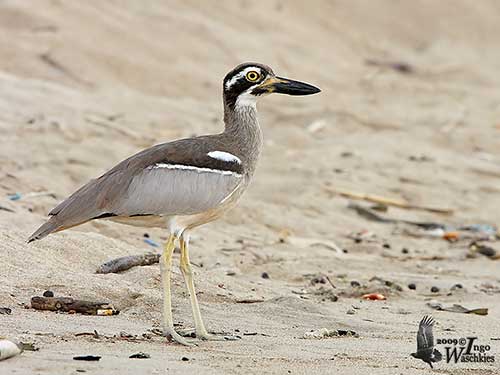
Fr: Œdicnème des récifs
Ang: Beach Thick-knee
All: Rifftriel
Esp: Alcaraván piquigrueso australiano
Ita: Occhione ripario
Nd: Rifgriel
Sd: kusttjockfot
Photographers:
Patrick Ingremeau
TAMANDUA
Dubi Shapiro
Dubi Shapiro Photo Galleries & Dubi Shapiro's Pictures on IBC
Ingo Waschkies
Bird Photography
Text by Nicole Bouglouan
Sources:
HANDBOOK OF THE BIRDS OF THE WORLD Vol 3 by Josep del Hoyo-Andrew Elliott-Jordi Sargatal - Lynx Edicions - ISBN: 8487334202
SHOREBIRDS by Peter Hayman, John Marchant and Tony Prater – Christopher Helm – 1986 – ISBN: 0747014035
Office of Environment & Heritage
Department of Environment and Heritage Protection
Birds in backyards (Birds Australia and Australian Museum)
CREAGUS@Monterey Bay (Don Roberson)
Wikipedia, the free encyclopaedia
Beach Thick-knee
Esacus magnirostris
Charadriiformes Order – Burhinidae Family
INTRODUCTION:
The Beach Thick-knee is a heavily built species with a massive bill well-adapted to its foraging behaviour. It feeds primarily on crabs and other small marine invertebrates.
This species occurs in Australia and South-east Asia islands where it can be found in undisturbed open beaches, reefs, mangroves and tidal areas. This solitary nester nests on the ground and a single egg is usually laid.
The Beach Thick-knee is threatened by human disturbance on beaches and by predation by introduced mammals. The small population is suspected to be declining and the species is currently listed as Near Threatened.

DESCRIPTION OF THE BIRD:
Biometrics:
Length: 51-57 cm
Weight: M: 870-1130 g – F: 980-1020 g
The Beach Thick-knee has brownish-grey upperparts. On the upperwing, the white and pale grey flight-feathers contrast with the blackish outer primaries showing white subterminal patches. The dark lesser coverts are bordered with white above and below. The short tail is olive-brown.
On the underparts, the breast is streaked pale brown, whereas belly, flanks and underwings are white, the latter with black-tipped outer primaries.
The heavy head is boldly marked with black and white. A broad, white stripe extends from above the eye to the ear-coverts. The top of the head is grey-brown, whereas malar area, chin and throat are white.
The massive, thick bill is slightly upturned, and we can see some yellow at base. The eyes are yellow. Legs and feet are pale greenish to brownish.
Male and female are similar.
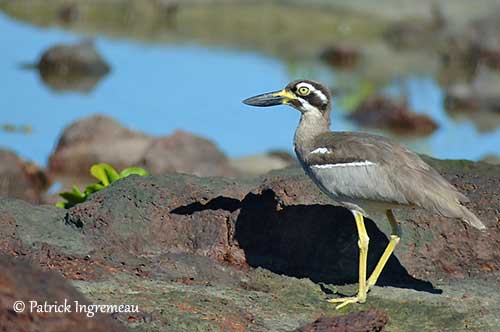
The juvenile resembles adult, but it has slightly paler upperparts with buff fringes to feathers, especially on the upperwing-coverts. The bare parts are duller than in adults.
RANGE:
The Beach Thick-knee is found on Andaman Islands and Malay Peninsula, E through Philippines, Wallacea and New Guinea to Australia, and also SW Pacific Islands, E to Vanuatu and New Caledonia.
HABITAT:
The Beach Thick-knee usually frequents open undisturbed beaches, reefs, islands, intertidal sand and mudflats. It prefers the beaches close to mangroves or estuaries. It is often seen at river mouths, on offshore sandbars, on coral reefs and atolls. It may sometimes occur on dunes at short distance inland, and around coastal lagoons.
CALLS AND SONGS: SOUNDS BY XENO-CANTO
The Beach Thick-knee gives a harsh, wailing, territorial call at night, a repeated bisyllabic whistle “kee-wee” or “kee-loo”.
When alarmed, it gives a short, weak call “quip” or “wik”, and sometimes a rising “quip-ip-ip”. We can also hear a raspy chatter.
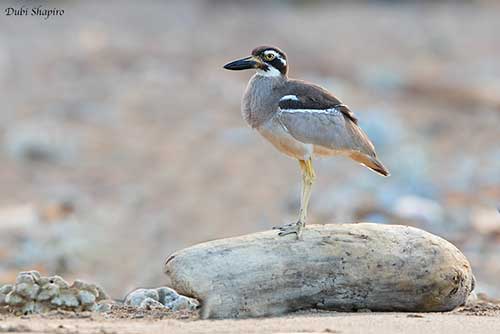
BEHAVIOUR IN THE WILD:
The Beach Thick-knee feeds primarily on crabs and other marine invertebrates such as crustaceans.
It forages like Ardea herons, watching for prey and stalking it once located. It may also run forwards with powerful forwards lunge. It probes into mud and sand, and occasionally in short grass too.
The massive bill is used for dismembering or broking crabs into small pieces, hammering the prey with the heavy bill before to swallow it.
The Beach Thick-knee is usually observed alone or in pairs, and sometimes in small groups. It is more active at dawn, dusk and at night, although the birds can be seen sometimes during the day when they are moving.
They are probably monogamous and breed in isolated pairs.
Information on courtship behaviour is not currently available. However, it performs acrobatic flights above the territory, as well as dancing and bowing displays on the ground.
The Beach Thick-knee is sedentary and remains on the same area for several following years. Some vagrants may occur far S of the usual range.
These birds can perform strong, sustained flight. If they are suddenly threatened, they are able to take flight immediately.
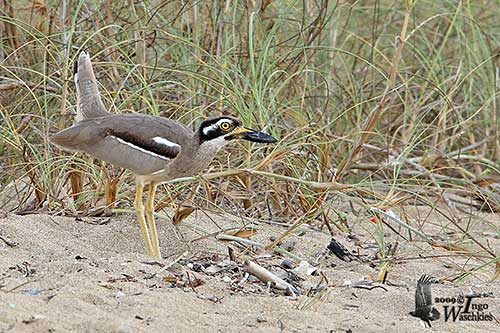
REPRODUCTION OF THIS SPECIES:
The breeding season takes place between April and November, with some variations depending on the range.
The Beach Thick-knee is solitary nester. The nest is on the ground on sandbars, sandpits, islands in estuaries, coral reefs and beaches associated with mangroves or estuaries.
The nest is a shallow depression usually unlined, but sometimes ringed with dead leaves and twigs.
The female lays a single whitish, pale brown or greyish egg with dark markings. She may lay a second egg if the first one is lost. The incubation lasts about 30 days, probably shared by both adults.
The chick is precocial and moves from the nest 24 hours after hatching. Both parents care for the chick that depends on them for long time, 7-12 months.
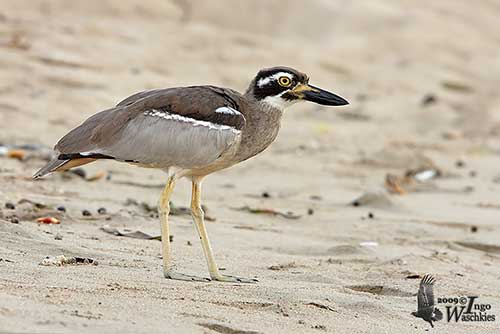
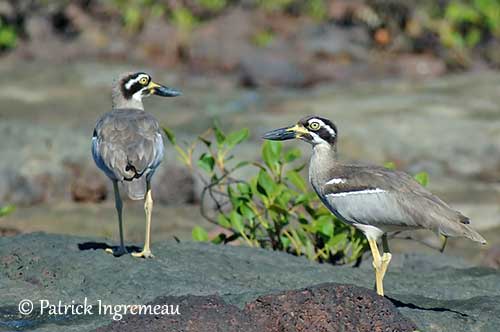
PROTECTION / THREATS / STATUS:
The Beach Thick-knee is vulnerable to human disturbance on beaches. It is threatened by introduced predators such as cats, dogs and pigs, but also naturally by raptors. High tides may sometimes involve nest and egg destruction.
The small population is roughly estimated to number 4,000 mature individuals, and it is suspected to be declining.
The Beach Thick-knee is currently listed as Near Threatened.